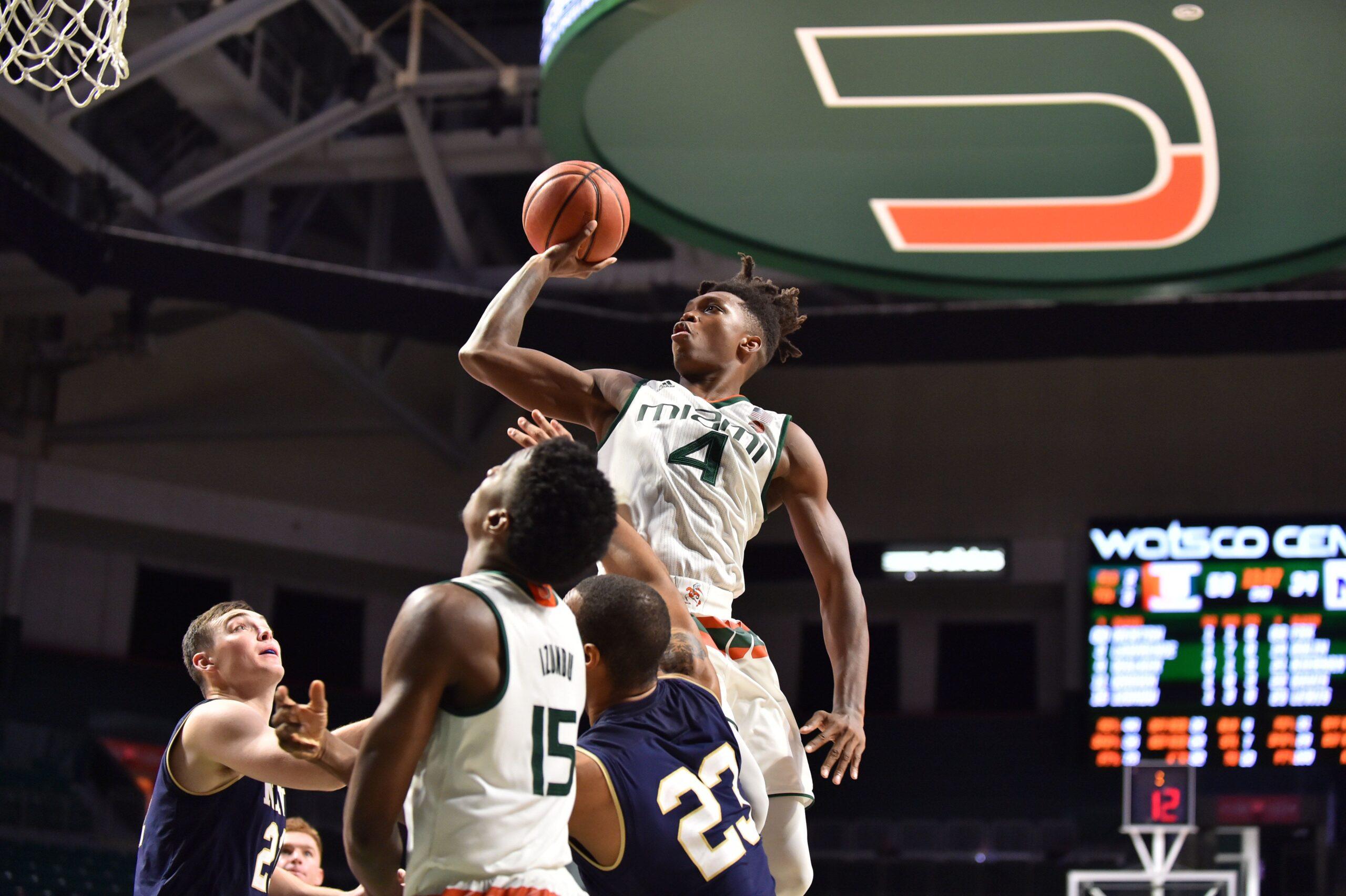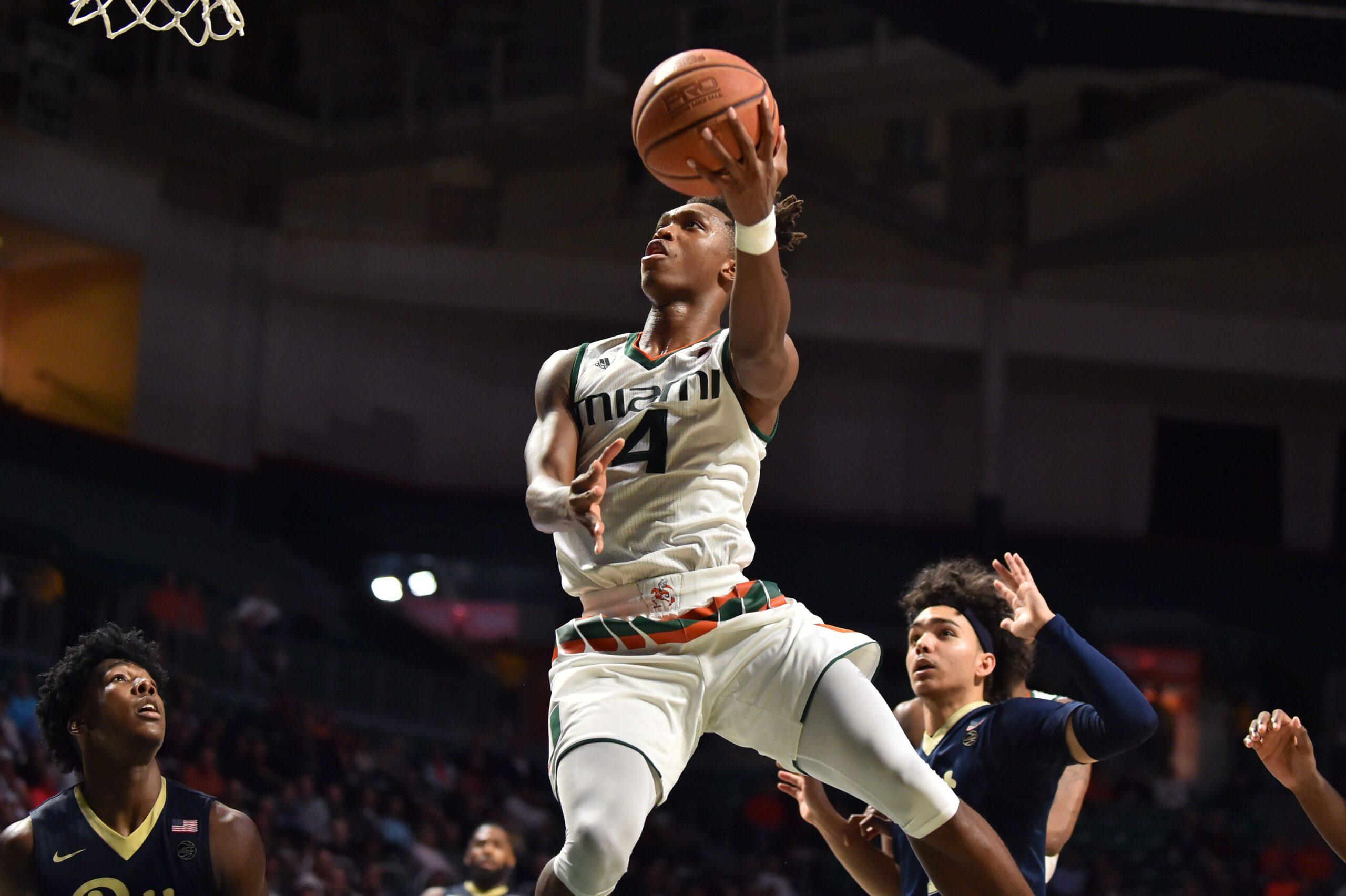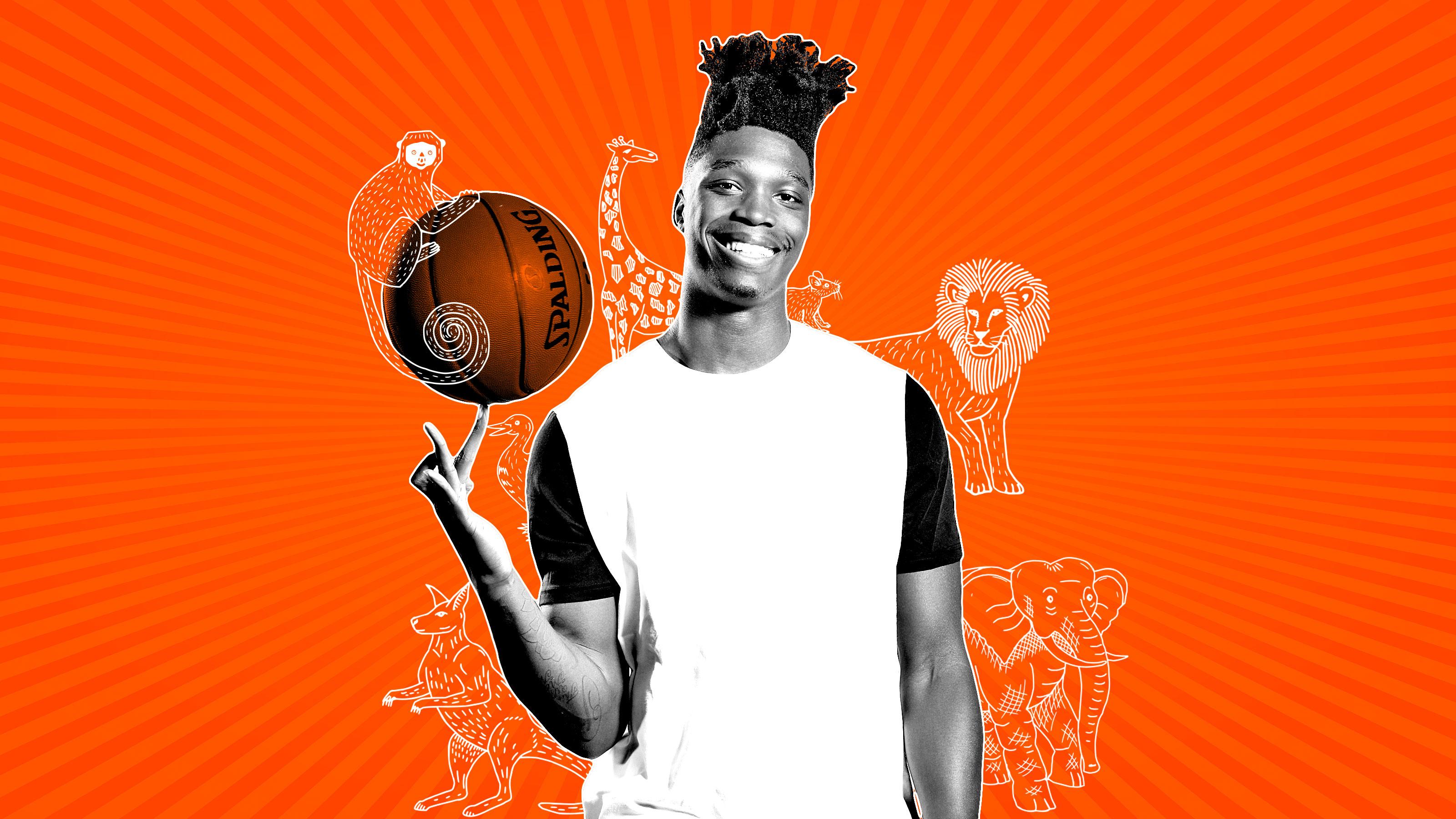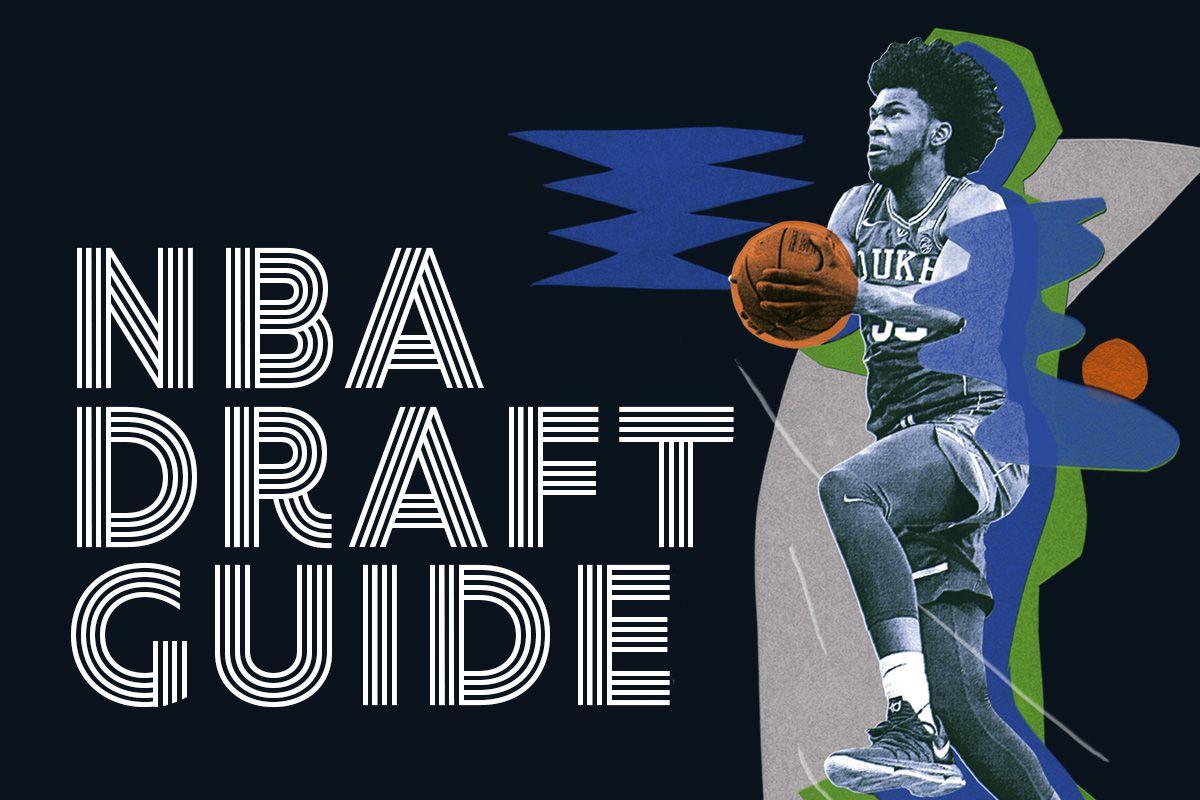Lonnie Walker IV Is Out of This World
One of the most intriguing talents in the NBA draft is also the most inquisitive. The Miami freshman standout has forced everyone he’s come in contact with to think a little deeper about the world around them. And he could be taking his galaxy brain to a franchise near you.Lonnie Walker IV wants you to open your mind. When was the last time you stopped to think about what we don’t know about the vast depths of the ocean? How about the newly discovered human organ? These are things Walker would like for you to consider. On this morning in June, Walker leans back on a folded chair, a stiff crown of dreadlocks rises from his high-top fade and glistens with sweat after a private workout in Thousand Oaks, California. His eyes widen when asked about his affinity for Animal Planet. He’s eager to play ecologist, psychology guru, and NBA prospect, all in one.
As one of the headlining wings projected to go in the first round of Thursday’s NBA draft, the 6-foot-4.5, 196-pound Lonnie stands out with his explosive athleticism, smooth pull-up shooting off the dribble, and the ability to defend multiple positions given his 6-foot-10 wingspan. He’s an active body with a hyperactive mind.
“When I’m playing the game, I think outside of the box,” Lonnie, a self-described geek and nerd, tells me. “It’s just about having a level of thought that keeps the mind interested to gain knowledge from anything you might see. Growing up, I was just a sponge when it came to knowledge of anything.”
There’s no need to compartmentalize interests with Lonnie; they all blend together and inform one another. Planet Earth (both the original and the sequel) is as vital to him as the old tapes of Allen Iverson and And1 street tour videos he watched growing up. He researched the waterfalls of French Polynesia and the ecosystems of remote parts of the world—all of it has widened the scope of his curiosity, which transfers onto the hardwood.
“It’s free-flowing. I’m not obligated. I’m not structured into doing one thing,” he says of his game. “I’m figuring out ways to be different and stand out, and play my game, and make sure I [put] my defender on his tiptoes rather than me being on my tiptoes.”
Walker is not your conventional one-and-done player, not your conventional shooting guard, and certainly not your conventional 19-year-old. He asks a lot of questions that often run counter to accepted truths. But one thing, in his mind, isn’t up for debate: “Whether it’s five, six, seven years from now, I kind of see myself as a future NBA star, a franchise player,” he declares. “Why not?”
Jim Larrañaga was fascinated by the jaguar. Not the car—the animal. So when it was time for his weekly phone call with Walker during the recruiting period from July to August 2015, the Miami basketball head coach made sure to ask him about it:
“Hey, I was watching a show. It was about a jaguar chasing down an ostrich, and that a jaguar is not really big enough to take down an ostrich by himself. He needs help.”
Walker didn’t miss a beat. “Oh, yeah, I’ve watched that, that’s great,” he said back to Larrañaga. “Ostriches are fast, and they’re big, and if they kick you, they can really kill you or hurt you.”

This is how most of their conversations went before Walker ever arrived at Coral Gables. Both parties understood the terms of engagement: They needed each other for basketball reasons. But basketball became the least important parts of their chats. Larrañaga appreciated how Walker made him think. “It’s very healthy. One of the things we stress is balance. You want to have balance in your life. [Lonnie] is a very well-rounded person. A lot of guys, all they want to talk about is basketball. But him, he’s got quite a diverse personality and interests.”
The coaching staff, however, never lost track of why they fell in love with Walker in the first place. Adam Fisher, Miami’s director-of-basketball-ops-turned-assistant-coach, had been keeping an eye on Lonnie because of their mutual Pennsylvania roots. Fisher told Larrañaga about Walker during the recruiting season and took every chance during the recruiting windows to watch him play at Reading High. Larrañaga watched Lonnie in a game during his sophomore season, and he was immediately smitten.
“When he ran the court, he reminded me of Usain Bolt. He flew down the side of the court like it was a sprint in a 100-yard dash,” Larrañaga told me. “He has those natural skills that are very easy to evaluate. He’s fast, he jumps, he’s graceful, athletic. He’s that prototype 2-guard in the NBA, but he’s probably going to be able to play both the 1 and the 2 once he gains more experience.”
At the combine in May, the NBA got a first-hand look at that overwhelming athleticism that Miami had seen in him back then. Of course, Lonnie also found other ways to steal the show. In an interview during the broadcast, Lonnie was asked about Kyrie Irving’s flat-earth theory. The question was a lighthearted fastball pitch right down the middle that Lonnie could have hit out of the park with a quick one-liner. Instead, he squared up and bunted. “The earth is not flat, in my opinion,” Lonnie said, to the surprise of everyone. “But the earth, on my conspiracy, the earth is definitely an illusion. That’s my conspiracy.” Last year, scientists reported that our planet’s existence as a hologram was a possibility.
Watching from afar, Lonnie’s high school coach Rick Perez could only laugh at the player who helped the Reading High Knights win the state title in his senior year. This moment was an affirmation, not a surprise. “That is Lonnie,” he told me over the phone. “You’re sitting here talking about the combine. … This is a young 19-year-old ready to go to the NBA, and here he is. The conversation changed to exactly what he likes to talk about.”
In 2016, NASA discovered an asteroid that has been in continuous orbit of the Earth for over a century; in essence, we have two moons. Lonnie mentions the fact unprompted, as a way to clarify the idea that there’s something new being discovered every day. Conventions are challenged constantly. “We’ve been alive for so long and each and every day we find something new,” Lonnie said. “It’s just too much, and it’s too much to grasp, to the point to where we can never say what is what and who is who, because at the end of the day, we don’t know.” Lonnie’s curiosity is infectious; his willingness to challenge his own preconceived notions empowers those around him to do the same. He talks about the roles of scientists and how breakthroughs and discoveries are made. Sometimes they’re the result of asking the right questions.
To understand Lonnie Walker IV, you have to understand the Lonnie Walker that came before him. Walker III filled Lonnie’s childhood room with everything from paint brushes to musical instruments. And a basketball. He had learned through reading books that some cultures believe putting a child in a room full of creative tools will lead them to their destiny.
But Walker III’s own interests also subtly paved a path that his son would follow. The elder had a knack for debate and a passion for basketball. Walker III played for Alvernia University, where he became the first player to score 1,000 points and tally 1,000 rebounds. In 2010, he was inducted into the school’s hall of fame.
Walker III had transferred to Alvernia from a New Jersey junior college where he became ineligible, and following a stint of homelessness, he made his way to Reading, still trying to pursue a basketball career. But once Lonnie was born in 1998, the priorities shifted. Though he still wanted to pursue a basketball career of some sort, Walker took on full single-parent responsibilities when Lonnie turned 3, working multiple jobs as a cook and selling T-shirts and sunglasses that he’d buy wholesale to sell at parades. He’d also take Lonnie to his own basketball games at summer league games around Philadelphia.
“We were in a basketball environment. Every day, we just breathed, slept, and ate basketball,” Walker III said.
Inevitably, the basketball became Lonnie’s inseparable companion. Literally. At 5 years old, he always carried around a ball that he referred to as his “friend.” It was around this same time that Lonnie would take a trip to the Philadelphia Zoo and the Georgia Aquarium in Atlanta where his grandparents lived. “That’s one of the top aquariums in the country,” he tells me. It was love at first sight. “I was looking up [things] strictly about Earth, the world, animals, and I couldn’t stop. It’s like an addiction now.”
This was what Walker III wanted for his son: balance, perspective, and an ability to think for himself. The real work came not when Lonnie was inserted into the AAU circuit at 8 years old, but rather in the books his father threw at him, the classical music he played for him, and the discipline he instilled in him. Basketball was a channel for purpose and a vessel for safety, to keep a routine so as not to get involved in the same drugs and violence that tragically killed more than one of Lonnie’s friends when he was growing up.
“Based on the statistics, he probably wasn’t going to make it out of the inner city, so he’s already beating the odds,” Walker III said. “The goal was always to improve his life. So, I made sure I challenged him with things that would stretch his mind-set, so that he wouldn’t be mentally limited.”
Inquisitiveness has been Lonnie’s equipment for living his entire life. “I don’t think he’s doing it for entertainment purposes, I just think he’s a throwback kid who has a vision of how he wants to go about life: open-minded. To me it’s kind of cool,” Walker III says. “Questioning stuff is his way of understanding for himself.” That curiosity takes specific forms on the court. There, the free-thinking turns into freestyling: Ballhandling and shooting have been emphasized in his daily training regimen because he knows how crucial shot-creation will be for him at the next level. Lonnie’s gained muscle and strength since early April when he declared for the draft, shedding old versions of himself like iOS updates. Basketball is his full-time job now, and it’s showing.
“It’s kind of scary. … I’m a greater player now than I was when I was at Miami,” he says. “I would destroy that old Lonnie Walker.”
He would probably challenge the old Lonnie’s notions of how the world works, too.
Adam Fisher received a surprising text from Lonnie in November 2016, just a few weeks before Walker would eventually sign his letter of intent to attend Miami.
“Coach, do you see me as a one-and-done player?”
They rarely talked basketball, and it would have been a lot less shocking if Lonnie had been texting him about National Geographic. But it was clear that Lonnie was coming to terms with the fact he was soon going to be playing Division I basketball, and possibly professionally not long after.
For three months last year, though, that possibility was put in peril. With 10 seconds left during a Hurricanes practice scrimmage on a Tuesday in July 2017, Lonnie opened up to receive an outlet pass. His right knee turned awkwardly and he crumpled onto the floor. Miami’s trainer, Javier Jimenez, rushed to Lonnie’s attention and helped him off the floor. The diagnosis came back clear: a torn meniscus. Lonnie would miss three months.
“I’m not going to lie, I was down in the dumps.” Lonnie said. “I talked to my grandmom. We talked for an hour. We would pray at night, we would pray in the morning.”
Larrañaga saw the hill Lonnie would have to climb, and he worried about how behind the curve he could be come season’s tipoff. Fisher, on the other hand, took the motivational route. He presented Lonnie with two choices. He could wallow in the injury, or he could take it as an opportunity to do something else, something he hadn’t done too much during high school, and something that he could actually do while he rehabbed his knee: watch film. It was an easy sell. Videos had taught him so much about the world at large; this time he would watch to learn about himself. So, they popped in his high school film and picked it apart. Then, they graduated to the pros.
“We watched Victor Oladipo, who kind of resembles my game: a very explosive guard,” Lonnie said. “We watched a lot of Klay Thompson and his ability to touch and shoot at his feet. We watched a lot of C.J. McCollum, his ability to come off rolls because Miami’s a pick-and-roll, four-out, one-inside team.”
It was basketball summer school, and it paid off. By the opener, Lonnie was ready to play, but not quite physically ready to start yet. Larrañaga used him as the seventh man in the rotation and limited his minutes. He couldn’t suppress his star recruit for so long. When ACC play arrived, It quickly became clear that Lonnie hadn’t just caught up to the learning curve. He had surpassed it. Everyone expected Lonnie’s athleticism to stand out, but his assertiveness took the conference by surprise. Though his stats weren’t gaudy (13.6 points, 2.3 rebounds, 2.3 assists, and 1.1 steals per game in conference), he showed the rare late-game assertiveness typically reserved only for stars.

“He is someone that doesn’t shy away from the big moments,” Larrañaga told me. “He’s one of the very few players that I’ve had over the years that was very, very comfortable shooting game-winning-type shots.”
Against Louisville in January, Lonnie hit an acrobatic game-tying layup with under five seconds left. He then followed it up with a block on a game-winning attempt in overtime that clinched the victory. At Virginia Tech in February, Lonnie scored eight of his 14 points in the final four minutes to close out the Hokies. When the Hurricanes played Virginia Tech later in the season, he hit a fadeaway baseline jumper to tie the game with less than a minute left. And when Miami cut a 14-point Boston College second-half lead to two on February 24, just a few games after starting point guard Bruce Brown went out for the season after having surgery on his left foot, Lonnie pulled up off the dribble for the game-winning, fadeaway 3 like he had been building up for this moment all summer:
With Brown out, the Reading native finally felt in a familiar position as the leader of the team, playing like the prospect everyone had anticipated. Miami made the NCAA tournament but was eliminated by Cinderella Loyola-Chicago in the opening round. Lonnie struggled, and in crunch time, he turned the ball over and missed a key free throw to seal the disappointing upset. It’s hard to imagine a worse way to end a college career.
Perez watched all the way from Reading, but he wasn’t worried. Ever since he first saw his future star play in a blacktop tournament in seventh grade, he had noticed how calm Lonnie was even when his game was rambunctious. Perez noticed that Lonnie rarely made the same mistake twice. “Lonnie never got stressed out. It was difficult for me to get angry at him because he always found a way to smirk and then [tell me], ‘Coach, it’s not that serious. … I’ll get it back.’”
Lonnie’s freshman season as a Hurricane didn’t end the way he wanted it to, but taken as a whole, he had done enough to earn a spot on the ACC’s All-Freshman Team and honorable mention on the All-ACC team. Despite an injury, early struggles, and an early exit in the tournament, the scouting outlook on Lonnie remained consistent with what it was before the season. Lonnie was projected as a first-round pick. He would be a one-and-done player, indeed.
Lonnie Walker III sits on the bleachers inside the Sports Academy in Thousand Oaks watching his son shoot 3s counterclockwise around the arc. Below him, Pat Riley, his hair slicked back as ever, sinks on a folded chair courtside, his arms crossed like they’re glued to his sides. A few seats over to his right, in the front row of the left side of the court, the Lakers’ Magic Johnson, wearing a black and white Adidas tracksuit, sits next to Rob Pelinka and watches the court. Jerry West is there, too; his bright blue Nike jacket stands out like a costume compared to his typical tailored-suit look.
What surrounds them all is a throng of other general managers, NBA coaches, agents, reporters, and a total of roughly 140 notebook-holding scouts. Attention is fleeting at this pro day; there are a number of prospects, from the lottery to the fringes of the draft, just hoping to catch someone’s eye.
Walker III, though, has his eyes fixed on Lonnie, talking out his son’s workout to no one in particular. “He loves going to his left,” the senior Walker says. “Nothing wrong with going to his left.” On cue, Lonnie hits three 3s in a row.
There’s no one in this room who is in love with Lonnie’s game as much as his dad is. He’ll admit his biases and even praise the other prospects in this draft, but he won’t hold back his rants about how he believes his son has one of the better skill sets in this draft.
“Is he 7-foot? No. Can he jump like [Hamidou] Diallo? No. But he can hit a jump shot, he can get his own shot, he’s good in the clutch, and he can defend,” Walker says to punctuate his impassioned tirade. He laughs. “You might see me flip my table at the draft if he doesn’t get drafted no. 1. You might, you might!”
Walker III might not get the chance to do so. The 2018 NBA draft will introduce a new format to the event’s proceedings, introducing each of the 20 green-room invitees (of which Lonnie is one) on stage prior to the Phoenix Suns’ first selection. Each invitee will walk the stage with family members, which means Walker III will be walking the stage after Lonnie’s name gets announced on Thursday. It will be a small moment of recognition for the elder Walker, who has already experienced a number of surreal moments while guiding his son through the process—moments that included meeting legends like Magic and West and listening to them rave about Lonnie, not just the basketball player, but the person. That was the goal all along.
“Me and my father always joked about [the NBA]. It’s kind of like landing on the moon. You’re like ‘Oh, I’m going to get to the moon. You best believe I’m going to get there,’” Lonnie said. “With us, it was like, ‘I can’t wait to get to the NBA.’ … But in the back of your head, y’all both know how slim of a chance it is. But now that I’m here, it’s like I’m on the moon. I’m like, ‘I’m here.’”
But like any intrepid explorer, he doesn’t look at the NBA as the mountaintop, instead as just another stepping stone to build upon the foundation of knowledge he’s created for himself. He’s already thinking about the next frontier before settling into the one right in front of him.
His curiosity about the world, and specifically third-world countries, isn’t all just for self-exploration. Lonnie wants to turn his research into action. First, he’ll start in Reading, he says, where he wants to provide books and school supplies for kids, and then eventually, do “like LeBron” and give scholarships, too. Then he’ll branch out to Africa and other parts of the world in need of assistance, bringing water, building schools, houses, and churches. “I want to change the world, somehow, someway,” Lonnie says. His father certainly won’t count out the possibility. “Whatever he does, I think it’s going to involve helping people,” Walker III says. “He helped me. He made me want to be a better person.”
For now, Lonnie will settle for making the NBA. But his second moon awaits.

